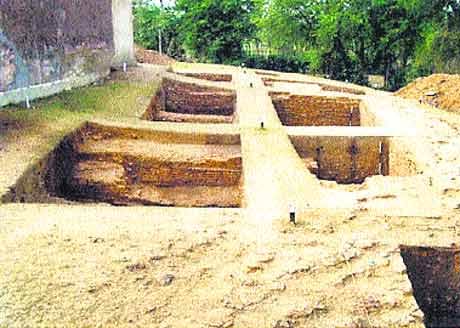1400-yr-old Monastery Unearthed
By Jhimli Mukherjee | Авг 30, 2008

KOLKATA: A 30-foot-high mound in a nondescript Bengal village, which has spawned many a legend and mystery, may yield one of the biggest archaeological finds in the country. The remains of a huge yet exquisite monastery are emerging from the sands of time.
Archaeologists believe it is one of the missing monasteries mentioned in Hiuen Tsang’s memoirs that was yet to be found. The monastery reportedly dates back to the seventh century – the time when the Chinese Buddhist monk made his 17-year walk across India.
The site of the find is in Moghalmari village, five kilometres from Dantan in West Midnapore. The excavation is being carried out by the archaeology department of Calcutta University, partly funded by the Archaeological Survey of India (ASI).
Hiuen Tsang had visited Bengal during the reign of King Sasanka and wrote in detail about Tamralipta and a monastery he saw here. But later records do not mention the existence of monasteries in this region. It has remained a matter of great interest among archaeologists and a source of many a debate. However, archaeologists feel that the Moghalmari excavation will finally set the record straight.
The 30-foot-high mound, which had hidden the monastery for centuries, was locally called Sakhisena and is the stuff of local legend. Local people attach a large number of myths to it, linking it to Sasanka and the pre-Pala times.
A couple of years ago, a team from the department had spent quite a few months in Moghalmari as part of a project backed by the Council for Scientific and Industrial Research. The experts were tracking an ancient navigation route passing through Dantan but stumbled on something much bigger.
“Our attention was quickly drawn to the mound by the local people, who showed us hundreds of artefacts and statuettes of stone, stucco and terracotta that they had collected for generations. These precious relics adorn homes, libraries, schools and other buildings in the village,” said Asok Datta, a faculty member who led the team of archaeologists.
This team then prepared a project report on the possible existence of a mastic site under the mound and sent it to ASI which immediately gave the permission for excavation.
Seals, terracotta remains, bricks, pottery and the like tumbled out of the dirt. Experts say it is turning out to be one of the largest monasteries in eastern India and certainly one of its kind in the country, owing to the fact that all the ornamentation on the walls and domes are made of stucco. “This is interesting because in the other monasteries, even those at Gaya, stucco designs are only in the sanctum sanctorum. But here, the entire monastery has stucco decorations all over. This is not all. We have excavated the eastern flank of the monastery and were amazed to find that the length of one side is 61 metres – comparable with the largest in the country,” Datta added.
The excavated portions of the monastery show cells that served as residences for monks lined on the sides of the building that opened into a central courtyard. “What has excited us most is the discovery of a rare Buddha stone sculpture from stratified context, representing the Buddha in the well known Bhumisparshamudra. Two stone heads, presumably of the Buddha, have also been found but we are waiting for ratification. So have a large number of terracotta seals,” Datta said.
The university sent the artefacts to Bratindranath Mukherjee, an expert in ancient seals. He dated the seals “unmistakably” to the seventh century and also deciphered them. “They are of the post-Gupta era, which dates them to the late 6th to early 7th century. Some of them bear sentences like, ‘propagation of dharma does not happen without a lot of self sacrifice,” Mukherjee said. The ornamentation on the monastery resembles Buddhist designs that were popular in the North West, especially Gandhar, say experts.
The Asiatic Society is documenting the excavation. “It is an amazing discovery. The first part of the publication is complete and will be released on Saturday during President Pratibha Patil’s visit,” said Ramkrishna Chatterjee, publications secretary of the society.















